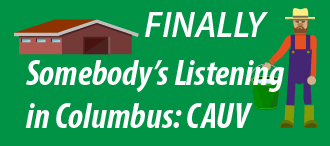Issues like former prison farms to be dealt with in Senate
 For the past several years farmers in Ohio have seen skyrocketing farmland property tax increases – that could be coming to an end with Ohio’s next state budget.
For the past several years farmers in Ohio have seen skyrocketing farmland property tax increases – that could be coming to an end with Ohio’s next state budget.
“We’ve had a couple days to review what the Ohio House is proposing and consider whether we can be fully supportive,” said Joe Logan, President of the Ohio Farmers Union.
“We’ve sought relief from the Ohio Dept. of Taxation for years with little relief, but finally our elected representatives are responding to the desperate cries of Ohio’s family farmers,” Logan said.
Ron Sylvester, OFU external relations director said Tuesday that the family farm organization is asking members to contact state representatives and express support for House passage of the state budget bill.
“We are concerned about the Administration’s and some legislators’ desire to work outside of normal open and competitive bidding processes to sell the thousands of acres formally farmed by the Ohio Dept. of Corrections,” Sylvester said.
“We do want the budget to pass the House this week and we’ll try to learn more about state leaders’ decision-making on these public lands in the Senate,” Sylvester said.
Ted Finnarn, OFU attorney and 41-year member of the Ohio Dept. of Taxation’s Agricultural Advisory Committee said what the House is proposing “will return the CAUV calculations to more reasonable values and allow conservation acres to be taxed at lower rates since these acres do not produce any crops.”
“The interest-capitalization rate used in the formula will be modified to lessen the influence of non-farm factors by increasing the holding period from five to 25 years,” said Finnarn. “These changes, resulting in lower CAUV values, will be phased in over two re-evaluation cycles (6years), so that they do not cause any dramatic impacts to local governments and schools.”
Ohio’s farmers have experienced farmland property tax increases reaching 300 percent in each of their past two to three triennial Current Agricultural Use Valuations. While the CAUV formula is complicated, one component, has been adversely affected by the U.S. Federal Reserve’s near zero interest rates – so-called quantitative easing – which lasted for years after the official end of the last recession.
CAUV was instituted so that agricultural land would be taxed at its “use” value and not it’s real estate development value. CAUV helps keeps farms in production and cuts down on unnecessary urban sprawl.


I find it very interesting that the “changes” are to be phased in over two CAUV cycles, 6 years, but my taxes weren’t “phased” in in 2009, 2012, and 2015 the State just told me “show me the money” but now when I might get some relief their attitude is “not so fast” we don’t want anyone to get “impacted to quickly.” I have properties that went up 1,430% 2015 compared to 2008, that’s 15 times more in 2015 than 2008! How is that not “impacting” someone too much? In fact my woodland increased 1,900%, or 20 times more! That’s a far cry from the 300 to 400% I keep reading in your articles about “CAUV changes are needed! There are people that have had 26 to 30 times more taxes 2015 vs 2008 and they live in northeastern Seneca County. Have you even looked for someone impacted to this extent? Is Ohio Farmer’s Union interested in investigating just what the true cause for this “explosion in CAUV values” is? Have you heard of the 2006 factoring of the yields thus implementing an automatic value increase every year! That seems to be a “dirty little” secret that apparently is “totally” off limits for discussion or even to reveal its existence to the multitude of CAUV landowners that are “completely” unaware of it! It seems that most everything you do falls extremely short of revealing and dealing with the true cause of the CAUV crisis, and the Ohio Farm Bureau is right in lock step with you! I don’t know if the membership to Ohio Farmers Union is really worth it for me, I am so disappointed with you performance in this area! I have been sharing information with your Ottawa Office for eight years, but the message just can’t get through the firewall”! Does anyone even read these comments or address them? Right now I doubt it!